Kidney development in the absence of Gdnf and Spry1 requires Fgf10
- PMID: 20084103
- PMCID: PMC2797609
- DOI: 10.1371/journal.pgen.1000809
Kidney development in the absence of Gdnf and Spry1 requires Fgf10
Abstract
GDNF signaling through the Ret receptor tyrosine kinase (RTK) is required for ureteric bud (UB) branching morphogenesis during kidney development in mice and humans. Furthermore, many other mutant genes that cause renal agenesis exert their effects via the GDNF/RET pathway. Therefore, RET signaling is believed to play a central role in renal organogenesis. Here, we re-examine the extent to which the functions of Gdnf and Ret are unique, by seeking conditions in which a kidney can develop in their absence. We find that in the absence of the negative regulator Spry1, Gdnf, and Ret are no longer required for extensive kidney development. Gdnf-/-;Spry1-/- or Ret-/-;Spry1-/- double mutants develop large kidneys with normal ureters, highly branched collecting ducts, extensive nephrogenesis, and normal histoarchitecture. However, despite extensive branching, the UB displays alterations in branch spacing, angle, and frequency. UB branching in the absence of Gdnf and Spry1 requires Fgf10 (which normally plays a minor role), as removal of even one copy of Fgf10 in Gdnf-/-;Spry1-/- mutants causes a complete failure of ureter and kidney development. In contrast to Gdnf or Ret mutations, renal agenesis caused by concomitant lack of the transcription factors ETV4 and ETV5 is not rescued by removing Spry1, consistent with their role downstream of both RET and FGFRs. This shows that, for many aspects of renal development, the balance between positive signaling by RTKs and negative regulation of this signaling by SPRY1 is more critical than the specific role of GDNF. Other signals, including FGF10, can perform many of the functions of GDNF, when SPRY1 is absent. But GDNF/RET signaling has an apparently unique function in determining normal branching pattern. In contrast to GDNF or FGF10, Etv4 and Etv5 represent a critical node in the RTK signaling network that cannot by bypassed by reducing the negative regulation of upstream signals.
Conflict of interest statement
The authors have declared that no competing interests exist.
Figures

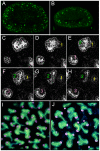
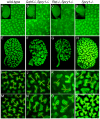
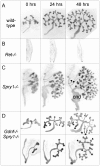
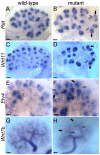
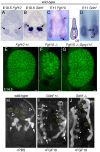
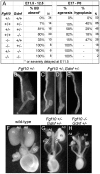


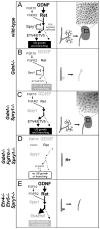
Similar articles
-
GDNF/Ret signaling and renal branching morphogenesis: From mesenchymal signals to epithelial cell behaviors.Organogenesis. 2010 Oct-Dec;6(4):252-62. doi: 10.4161/org.6.4.12680. Organogenesis. 2010. PMID: 21220964 Free PMC article.
-
Sprouty1 is a critical regulator of GDNF/RET-mediated kidney induction.Dev Cell. 2005 Feb;8(2):229-39. doi: 10.1016/j.devcel.2004.12.004. Dev Cell. 2005. PMID: 15691764
-
The tyrosine phosphatase Shp2 acts downstream of GDNF/Ret in branching morphogenesis of the developing mouse kidney.Dev Biol. 2011 Dec 15;360(2):310-7. doi: 10.1016/j.ydbio.2011.09.029. Epub 2011 Oct 8. Dev Biol. 2011. PMID: 22015719
-
GDNF/Ret signaling and the development of the kidney.Bioessays. 2006 Feb;28(2):117-27. doi: 10.1002/bies.20357. Bioessays. 2006. PMID: 16435290 Review.
-
Intracellular RET signaling pathways activated by GDNF.Cell Tissue Res. 2020 Oct;382(1):113-123. doi: 10.1007/s00441-020-03262-1. Epub 2020 Aug 20. Cell Tissue Res. 2020. PMID: 32816064 Review.
Cited by
-
Cytokeratin 15 marks basal epithelia in developing ureters and is upregulated in a subset of urothelial cell carcinomas.PLoS One. 2013 Nov 18;8(11):e81167. doi: 10.1371/journal.pone.0081167. eCollection 2013. PLoS One. 2013. PMID: 24260555 Free PMC article.
-
Extracellular matrix dynamics in tubulogenesis.Cell Signal. 2020 Aug;72:109619. doi: 10.1016/j.cellsig.2020.109619. Epub 2020 Apr 2. Cell Signal. 2020. PMID: 32247774 Free PMC article. Review.
-
MAPK/ERK Signaling in Regulation of Renal Differentiation.Int J Mol Sci. 2019 Apr 10;20(7):1779. doi: 10.3390/ijms20071779. Int J Mol Sci. 2019. PMID: 30974877 Free PMC article. Review.
-
Fibroblast Growth Factor 10 Attenuates Renal Damage by Regulating Endoplasmic Reticulum Stress After Ischemia-Reperfusion Injury.Front Pharmacol. 2020 Feb 7;11:39. doi: 10.3389/fphar.2020.00039. eCollection 2020. Front Pharmacol. 2020. PMID: 32116715 Free PMC article.
-
Nephron Progenitor Maintenance Is Controlled through Fibroblast Growth Factors and Sprouty1 Interaction.J Am Soc Nephrol. 2020 Nov;31(11):2559-2572. doi: 10.1681/ASN.2020040401. Epub 2020 Aug 4. J Am Soc Nephrol. 2020. PMID: 32753399 Free PMC article.
References
-
- Moore MW, Klein RD, Farinas I, Sauer H, Armanini M, et al. Renal and neuronal abnormalities in mice lacking GDNF. Nature. 1996;382:76–79. - PubMed
-
- Pichel JG, Shen L, Sheng HZ, Granholm AC, Drago J, et al. Defects in enteric innervation and kidney development in mice lacking GDNF. Nature. 1996;382:73–76. - PubMed
-
- Sanchez MP, Silos-Santiago I, Frisen J, He B, Lira SA, et al. Renal agenesis and the absence of enteric neurons in mice lacking GDNF. Nature. 1996;382:70–73. - PubMed
-
- Schuchardt A, D'Agati V, Larsson-Blomberg L, Costantini F, Pachnis V. Defects in the kidney and enteric nervous system of mice lacking the tyrosine kinase receptor Ret. Nature. 1994;367:380–383. - PubMed
-
- Costantini F, Shakya R. GDNF/Ret signaling and the development of the kidney. Bioessays. 2006;28:117–127. - PubMed
Publication types
MeSH terms
Substances
Grants and funding
LinkOut - more resources
Full Text Sources
Other Literature Sources
Molecular Biology Databases

